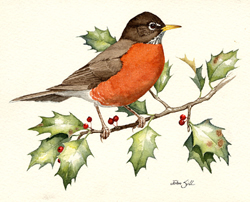Find a Bird - BBA1
Breeding Bird Atlas 1 Species Accounts
American Robin
Turdus migratorius
Egg Dates
April 12 to August 10
Number of Broods
two; rarely three

American Robins are among the most ubiquitous nesting species in Massachusetts, occupying open lands of all description and forested areas, as well, usually where there is scant understory and interspersions of small clearings. Originally birds of the forest, robins responded positively to the clearing of land and settlement and are thought to be many times more common today than they were in the colonial period. They are especially abundant in suburban areas. However, in heavily suburbanized regions characterized by intensive human activities and large numbers of domestic predators, reproductive success may be quite poor, and such populations may be maintained only by immigration.
True northbound migrants appear in early March, and passage occurs throughout April, with peaks in late March and early April. Local males waste no time in establishing their territories. The defended territory, over which the male stands guard throughout the nesting season, includes the immediate vicinity of the nest and usually an additional ill-defined area of lawns and gardens. The territorial song of the robin—a loud and continuous rich caroling, rising and falling in pitch and usually described as cheerily-cheerily-cheerily-cheerrio—is first heard on warm mornings in late March and early April.
Dawn and dusk choruses reach a peak in late April but continue, gradually diminishing in intensity, through mid-July. The familiar call notes of the robin, often rendered kwee-kwee-kuk-kuk-kuk or sometimes puck-kuk-kuk-kuk, are uttered with emphatic jerks of the tail and at varying speeds and intensity of delivery, depending on the bird’s emotional state. The flight call, a thin see-lip, may be heard at any time of the year.
Robin nests are commonly built in trees and shrubs, reportedly as high as 70 feet but usually 10 to 25 feet. A preference for coniferous sites is evident early in the season. Robins occasionally nest on porches, sheltered windowsills, and the eaves of buildings, and artificial nesting shelves are sometimes accepted. Rarely, nests may be found in the crevices of natural cliffs or boulders, in stone walls, and even on the ground.
In Massachusetts, 118 nests were located as follows: 65 on conifer branches at an average height of 11.3 feet, 24 on deciduous branches at an average height of 11.7 feet, 13 in shrubs at an average height of 6.5 feet, 4 in vines at an average height of 10.5 feet, and 12 on buildings at an average height of 15 feet (CNR). The nest is a deep bowl of coarse twigs and grasses, with the inside walls and bottom reinforced substantially with mud and lined on the inside with fine grasses and other pliable fibrous material. Construction is done almost entirely by the female and typically takes 4 to 6 days, occasionally longer if heavy rains wash out the mud work. Usually, a new nest is built for each brood; however, occasionally a nest may be refurbished for a second brood.
Up to 5 days may elapse before the first egg is deposited in a completed nest. Once egg laying begins, eggs are laid on successive days, and incubation starts on the evening following the deposition of the second egg. The female, which usually spends 80 percent of her time on the eggs, accomplishes incubation. Clutches of three or four eggs are the rule; about 2 percent of clutches contain five eggs. The incubation period is 12 to 14 days. In Massachusetts, eggs have been found in nests from the second week of April until a late hatch date of August 10 (Nice 1933).
Upon hatching, the young are immediately tended with great interest by both parents. The young are capable of begging for food when they are six minutes old and cheep incessantly at two and one-half hours of age. Massachusetts nestlings have been recorded from May 2 to August 14 (CNR), and there is a very late record for a nest with three young that fledged on September 13 (EHF). Fledging occurs at 14 to 16 days, at which point the male largely takes charge of the young, freeing the female to prepare a new nest and lay a second clutch of eggs. Of 125 nests in the Commonwealth, 41 fledged young, 31 failed, and 53 had an unknown outcome (CNR). Because there is a high loss of both eggs and young, renesting attempts are frequent, and most pairs are able to raise only two broods in a season.
Dispersal from the parents’ territory is rather slow, with many juveniles remaining within a half-mile of their birthplace two months after fledging. Most juveniles eventually join feeding flocks of adult robins in areas of abundant fruit. Communal night roosting is an interesting facet of robin social structure. Even during the nesting season, males congregate in small roosts at night. By early July, these communal roosts become more obvious, and the number of robins using them swells throughout the summer as more and more non-nesting birds join the ranks. These roosts, in which juveniles often heavily outnumber adults, are used nightly until mid-September, after which time the roosts break down and the habits of the birds change markedly. Small flocks of robins then begin radiating across the countryside searching for wild fruit. Southward migration is most pronounced between the third week of September and the third week of October, with the last migrating robins usually gone by the end of November. In some years, however, large numbers may linger into early winter.
Massachusetts robins winter from the Carolinas southward throughout the Florida peninsula and westward through the Gulf states to eastern Texas. Most return to nest within 25 miles of their birthplace.
Map Legend and Data Summary
Atlas 1 data collected from 1975-1979


Note: very common and widespread; absent on treeless islands
Bradford G. Blodget



